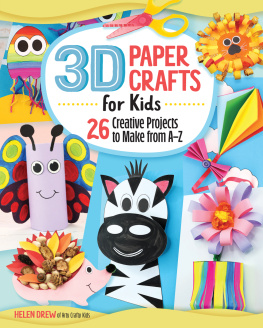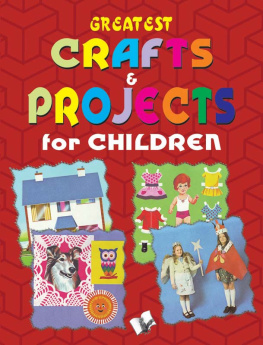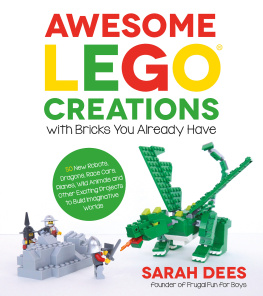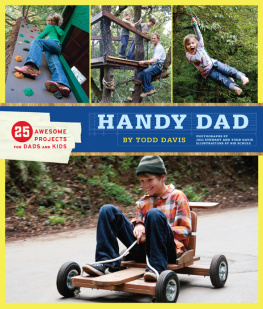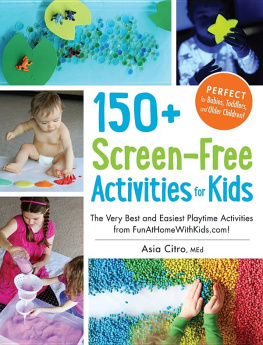Contents
Guide
C. R. A. F. T.
CREATING REALLY AWESOME FREE THINGS
100 Seriously Fun, Super-Easy Projects for Kids
JAMIE DOROBEK, Creator of C.R.A.F.T.

Avon, Massachusetts
CONTENTS
DEDICATION
To my sweet Maxwell, for your inspiration to write this book. I love you more than the moon and the stars and the sun and the sky! And to my Mom for encouraging and inspiring my creativity as a child. I love you, Mom!
INTRODUCTION
DID YOU KNOW that you can make monster feet out of tissue boxes? A sheep out of a ziptop bag and some shredded paper? A watch for dress-up out of an empty toilet paper tube?
Creativity is contagious, and throughout Creating Really Awesome Free Things youll find 100 fun and easy kid crafts that teach you how to use what you have to make some super-fun free things! I came up with most of these crafts on my own (Im a mom, craft blogger, and former teacher, so creativity is my middle name), but youll find some contributor projects scattered throughout the book as well. I hand-picked each contributor because I love his or her individual sense of style and perspective on kids in general. Most of the contributors have kidsand two are actually kids themselves. But no matter who came up with the craft, each project is pretty much free!
So what do I mean when I say free? Well, the projects in this book are made up of items that you most likely already buy and will have on hand. Think water bottles, cotton balls, tape, and rubber bands. So by free, I really mean one of two things: (1) You will use the packaging of an item you most likely already buy (such as cereal boxes or egg cartons) or (2) you will use the actual contents of an item that you probably already have on hand (such as cotton swabs, permanent markers, and sandpaper). Make sense? I want you to feel empowered by the idea that you already have all of the fanciest kid crafting supplies at your fingertips. There is no need to go out and buy special things. And, to make it easy for you to find your amazing free crafting materials, the book is divided up by rooms in your house. Why waste time searching for materials when you can be crafting with your kids!
In addition to the crafts, youll find a chapter full of information about what you should save from the recycling bin (candy wrappers, magazines, tin cans), what you probably already have on hand (string, coffee filters, paper plates), and what basic craft supplies youll find yourself using over and over again (glue, paint, hole punch). Throughout the book, youll find Keep It Creative! sidebars that give information on project variations and alternatives. And youll also find Awesome Fact sidebars containing trivia about the animal, topic, or item a craft is themed around; these are designed to help you inspire a love of learning in your kids and spark conversations that will continue long after youre done crafting.
The majority of the crafts in this book can be 100 percent completed by preschool-age or elementary schoolage kidsbut you know your kids best, so let them do whatever they can, and be available to help them out with the rest! A few of the crafts utilize materials that will absolutely need adult supervision, including a hot-glue gun, utility knife, and drill (and onereally awesomecraft actually needs a corkscrew), so just be sure to read through the instructions before starting a project.
I promise you will have fun crafting with your kids, and you might even want to get in on the fun. The in Chapter 3 can really spruce up a plain tee and a pair of jeansjust saying! So get ready to rifle through your home office, clean up your kitchen, and even spend some time collecting materials in your own backyard as you start creating a bunch of really awesome free things with your kids.
Chapter 1
WHERE TO START
So you want to start crafting, but what should you have on hand? Where does all this free stuff come from? This chapter will ensure that you and the kids are ready for spontaneous craft sessions whenever inspiration hits.
Here youll find a variety of information on the various materials that will let you make all 100 kid craft projects in this book. Youll also find ideas for alternative materials just in case you dont have something that a project calls for. For example, if you dont have paint stir sticks that are needed to complete a project, you can easily swap those out for chopsticks, Popsicle sticks, or even twigs from nature! Ive also included some fun ideas on how to make crafting with kids a little less messy, slightly more organized, and... you guessed it... free!
Items to Save
Now, I dont want to encourage you to be a hoarder, but I do want you to consider saving a few everyday items from the trashcan or recycling bin. Im all about practicality, and no one has room in her house to store every egg carton and plastic milk container shes ever used. My solution? I keep one small cardboard box that is about 20" 14" stored in the garage, and fill it with items to save for crafting. I typically use one of those economy size diaper boxes, since they are so readily available in my house! This keeps my hoarding to a minimum and the free craft supplies flowing! But what exactly should you hold on to? These items include the following:
Plastic Food Containers
This category includes items such as plastic milk jugs, yogurt containers, baby formula containers, and water bottles. Empty water bottles will magically turn into polar bears, milk cartons will be turned into sun catchers to make your windows sparkle, and baby formula containers also make really great drums when paired with chopsticks! In this book, youll use gallon milk jugs and 16-ounce, plastic water bottles for multiple crafts.
Keep It Creative!
Crafting with what could be considered trash is also a great way to talk to kids about the three Rs: Reduce, Reuse, Recycle! Things like egg cartons, plastic food containers, and cereal boxes are some of the very best craft supplies a kid (or parent) could ask for!
Egg Cartons
Youll find that egg cartons come in handy in any number of ways. They are the basis for the in Chapter 2 and they are fantastic when used as paint pallets for kidsespecially when a project calls for a variety of different colored paints! Just pour a little bit of each paint color into each egg indent and you have an inexpensive, mess-free way to keep your kids creativity flowing. Then, once the project is finished, you can just toss the egg carton, making clean up a breeze as well!
Cardboard Food Boxes
This category includes items like cereal boxes, the boxes for frozen foods, and cracker boxes. Cardboard food boxes make the perfect blank art canvas for kids. They are sturdy enough to be painted on, but also easy enough to cut with a simple pair of scissors. To store these, use your finger to rip the seams on the side and on the bottom so that the box lies flat. I keep at least ten empty, flat food boxes in my garage stash. If you dont have cardboard food containers on hand, you can typically replace these with notecards, card stock, brown paper bags, the fronts of notebooks or folders, or even plain white printer paper.
Tin Cans
Lots of food comes in tin cans and you probably just throw these in the recycling bin after you pour out the green beans, spaghetti sauce, or soup. But those tin cans can provide hours of fun, so keep some clean ones stored in your craft bin! For most of the projects in this book, its ideal to use a 16-ounce or 18.6-ounce soup can, but you can absolutely substitute whatever size tin can you have on hand. If you dont have tin cans in your stash for a project, feel free to use an empty glass jar or even a plastic food container, such as a yogurt container.


